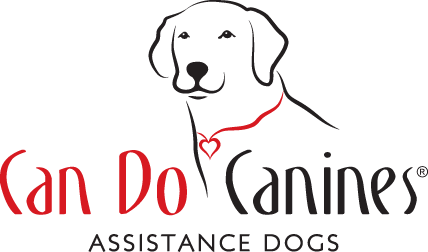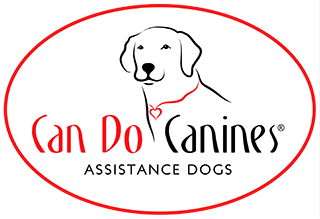Introducing a new dog to your existing household is a process! Even if everyone gets along right away, the new dog still has to learn the routines of your household and how everyone fits into that picture. This affects everything, from who gets access to the dog beds and each crate, to the order everyone is fed, and even if they have to wait in line to get water after coming back inside from play!
If you have other pets besides dogs, it may even be the first experience the Can Do Canines dog has with seeing that species up close. They need time to learn the body language and communication of the other animals.
Introduction to Other Dogs
Initial Meeting
In the ideal world, the new dog should meet only one of your pets at a time, and this should be done in a neutral location with plenty of space for each dog to see each other without forcing interaction.
The best way to do this is to take a walk with separate handlers for each dog. Don’t let the dogs directly sniff each other. Help them remain calm and prevent them from rude hard staring. Start walking, allow them to air sniff and let some of that initial burst of excitement die down. Remember that these dogs will be sharing a space inside your house. You don’t want them to be all ramped up at the thought of each other!
Bonus points if you can take the dogs to an area where you can then switch them to long lines and let them do lots of side by side sniffing of the ground. Keep moving so the dogs don’t start to think about a play session with each other. If you find they really want to play, you will need to continue your walk until you can safely get to an area where you can let them off leash (such as your yard).
If you don’t have access to a yard, let them do a quick “say hi” sniff of each other towards the end of your walk. Interrupt this every 3 seconds to call each dog come back to their handler to get a treat before resuming walking or releasing them again. Greetings on leash can add tension, and are not something we want them to start expecting to be able to do as assistance dogs.
If things are going well, it’s time to let the new dog inside! Try to put your other dogs back outside or in crates so that the new dog has time to explore their new house and get used to things without having to worry about being followed by the other animals.
If you have other pets, have the new dog drag a leash so you can easily interrupt them from any unwanted behaviors.
Let the dogs greet outside again if possible before letting everyone in the house together.
Important Objects
When the dogs are all inside with each other, you will likely need to pick up all bones, toys and empty food bowls until you can see if the dogs communicate with each other kindly. It’s okay to only give them their bones when they are in their crates and to feed in crates too. If your dog has a favorite dog bed that they might not want to share, make sure to put that away for now too.
As you start to see their relationship grow, you may decide to bring certain objects back out. Make sure to have plenty of available choices around them. A good rule of thumb is at least two for each dog! So if you now have two dogs in your house, you will want at least four Nylabones out.
The number of available sleeping areas should also be high. Crates, dog beds and the couch might be options. You can choose, or the dogs can choose, if all are available for sharing or if you want to encourage each dog to have their own spot. You would need to step in and help redirect the new dog to a new sleeping area if that is the case!
Remember, only one dog should be allowed in a crate at a time! While some dogs may love to cuddle up, let them do this on a dog bed and not in a confined box where it’s harder to escape if agitated.
Co-Existing
You will likely need to use baby gates or crates to continue to separate the dogs for a period of a few days to a few weeks as they get to know each other and the house rules. Even if everyone is getting along, there will be certain times of day that having them separate can be helpful to prevent over-excitement or one dog from harassing the other dog to keep playing.
You may choose to have a “no playing inside” rule. You might be okay with light wrestling, but put your foot down to actual running inside. To help enforce this, have separate places you can send each dog to for “rest time.” You can have treat containers located around your house to help the dogs calm down and respond quickly. A rest time can be for 10 seconds before being released, or you may choose to have a longer rest time by putting one dog into a crate, xpen, or on the other side of a baby gate.
If you find that one of the dogs is harassing the other and not getting the hint, you will also need to step in often to help back up the other dog. While it’s nice if a dog can “tell off” the other dog in an appropriate way, they should not feel like they have to be doing this all the time. You will need to help be their advocate by redirecting the playful dog to a bone to chew on instead, or redirecting them for a bit of “rest time.” Having the playful dog drag a leash can be helpful to enforce manners! You could even tether the dog to your body by tying a leash around your waist, or tether them to your chair to help them learn how to relax in the sight of their friends.
Other Pets
If you have other small animals in your house, you will need to closely manage their interactions and ideally teach the dog that they are not a source of interest. We want them to develop a bored attitude about other animals.
Small Animals
Small animals like guinea pigs, rats, bunnies and ferrets might need you to put an exercise pen around their cage to create a barrier from the dog being allowed to directly approach and sniff the animals. Most small animals are prey animals and can be easily scared of new dogs, even if they are used to living with your own dog.
This barrier around their cage also allows you to control how interested the dog is with the other animals. Watching them calmly is okay, but wanting to obsessively stare, stalk or play with the other animals is not appropriate. You can use treats to help bring the dog’s focus back on you when the small animals are catching his attention. Or you may need to block visual access by throwing a blanket over the exercise pen so the dog can’t see in. Continually redirect the dog from the cage by encouraging them to go to their mat or chew a bone.
Animals that move quickly, such as rats and ferrets, are going to be more challenging to keep your dog into a calm watch mode and not activate their prey drive. Go slowly with this training! Consider using a snuffle mat or shaggy rug to drop “find it” treats on to encourage the dog to lower their head and break focus, and to get into sniff mode as they need to search for the treats.
Remember, your dog does not need to make physical contact with the animals in order to learn to be calm around them.
Cats
Cats are harder than other small animals since they typically have free access to our house. In order to help the cat feel safe with the presence of a new dog, make sure they have plenty of places to escape to where the dog can’t reach them. Cats prefer using height to escape from predators, so having furniture the cat is allowed on or shelves can help them feel brave!
You may also wish to baby gate off certain rooms so that the cat can either jump the gate or walk through a small cat hole at the bottom. (Warning: most pet gates with an opening are also large enough for puppies or medium-sized dogs to fit through.) Keep their litterbox in this safe room so that the cat doesn’t need to worry about being bothered and the dog doesn’t learn how tasty kitty morsels can be. Ingesting cat litter can also lead to a medical issue of a blockage. The cat’s food should be either kept in this room or at a high location out of reach of the dog.
If the cat is avoiding the dog, don’t take the dog into their safe room, even if on leash. Any introductions of the dog to the cat should be done by the cat’s choice. While the dog being able to physically sniff the cat is inevitable over time, don’t force the cat to endure this interaction. The cat should always be able to escape. This will also help with the dog not “needing to” directly interact with a person, dog or other animal in order to calm down,
If your cat is prone to running away from the dog, you will also want to have the dog wear a long leash inside the house so that you can easily redirect the dog. Chasing can be a fun habit that is hard to break once started. If the dog is in mid chase and you’re not close by to directly stop them, try cuing “find it!” and drop some treats at your feet and/or shake a treat jar as you get ready. You will want to first train the “find it” cue frequently when nothing is happening so that your dog can react without thinking and needing to weigh the value of food vs chase.
Work on the dog learning to focus on you and eat cookies while the cat is walking about. Putting the dog in a crate can also be a great way to condition calmness around the cat and to prevent the dog learning to harass the cat.




